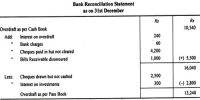Methods of Trial Balance
Trial balance is a statement which shows debit balances and credit balances of all accounts in the ledger. Since, every debit should have a corresponding credit as per the rules of double entry system, the total of the debit balances and credit balances should tally (agree). In case, there is a difference, one has to check the correctness of the balances brought forward from the respective accounts. Trial balance can be prepared in any date provided accounts are balanced.
A trial balance can be prepared in the following methods.
(i) The Total Method: According to this process, the total amount of the debit side of the ledger accounts and the total amount of the credit side of the ledger accounts are recorded. Under total method, trial balance is prepared by taking up the total of debits and credit of all ledger accounts. This type of Trial Balance is known as the ‘Gross Trial Balance’.
(ii) The Balance Method: In this process, only the balances of an account either debit or credit, as the case may be, are recorded against their respective accounts. Under balance method, only the balances of all the ledger accounts are taken up to prepare the trial balance. The debit balance is shown in debit column and credit balance is shown in credit column of amount.
(iii) Compound Method: Compound method is the combination of both the methods, total method and balance method. Thus, compound method is also known as total cum balance method.
The balance method is more widely used, as it supplies ready figures for preparing the final accounts.














